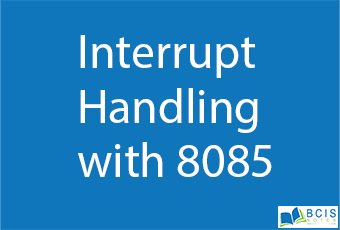
Interrupt Handling with 8085
Interrupt handling is a key function in real-time software and comprises interrupts and their handlers. Only those physical interrupts which of high enough priority can be centered into system interrupt table. The software assigns each interrupt to a handler in the interrupt table. An interrupt handler is just a routine containing a sequence of operations.
Interrupts are the signals generated by the external devices to request the microprocessor to perform a task. There are 5 interrupt signals, i.e. TRAP, RST 7.5, RST 6.5, RST 5.5, and INTR. Vector interrupt − In this type of interrupt, the interrupt address is known to the processor. Interrupt handling is a challenge as interrupts force the CPU to enter supervisory mode—hence interrupt routines cannot be implemented completely in userspace.
Interrupt Processing in 8085
- Interrupt signals send by an external device to the processor, to request the processor to perform a particular task or work.
- Mainly in the microprocessor-based system, the interrupts are used for data transfer between the peripheral and the microprocessor.
- The processor will check the interrupts always at the 2nd T-state of the last machine cycle.
- If there is any interrupt it accepts the interrupt and sends the INTA (active low) signal to the peripheral.
- The vectored address of a particular interrupt is stored in a program counter.
- The processor executes an interrupt service routine (ISR) addressed in the program counter.
Handling interrupts is at the heart of a real-time and embedded control system. The actual process of determining a good handling method can be complicated, since numerous actions are occurring simultaneously at a single point, and have to be handled rapidly and efficiently. This subsection will provide a practical guide to designing an interrupt handler and will discuss the various trade-offs between the different methods.
You may also like Interrupt service routine

Leave a Reply